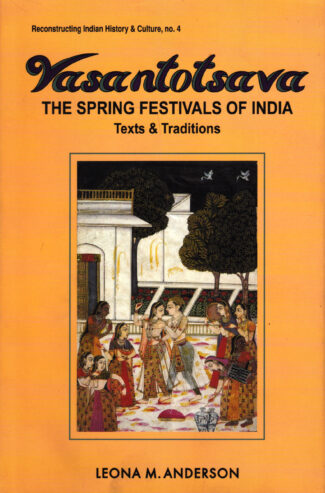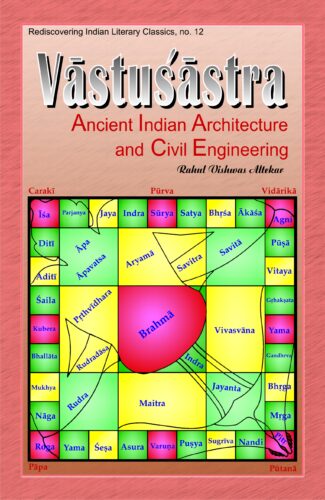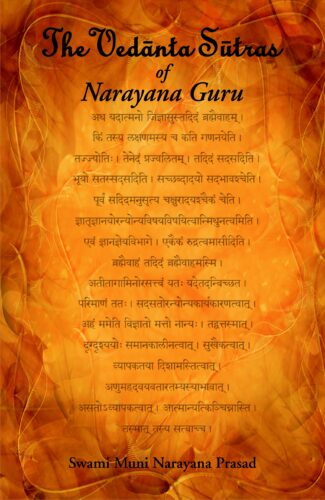Showing 291–300 of 322 results

This study treats Vasantotsava as a thematically unified generic whole embracing a range of spring festivals, pansectarian in character and incorporating various rituals. It reassesses Sanskrit texts to explore the rituals, symbols and underlying motifs of the Vasantotsava.
This study treats Vasantotsava as a thematically unified generic whole embracing a wide range of spring festivals including the Phalgunotsava, Caitrotsava, Phalgu, Madhutsava, Madanamahotsava, Madanatroydashi, Anangotsava, Madanadvadaishi, Kamotsava, Shripancami, Yatramahotsava, and Holaka (Holi). These festivals are pansectarian in character and incorporate a variety of ritual observances practised through- out the Indian subcontinent. Signifying the termination of winter and announcing the advent of spring, the celebration was a diverse and complex spectacle situated within the framework of Indian ritual and myth. On the basis of puranic and ritual texts, folk tales, drama, poetry, and narratives in mixed prose and poetry (campus), Dr. Anderson addresses complex issues of indigenous ritual, mythology, and tradition. The Vasantotsava incorporates a broad spectrum of human concerns: in the sphere of polity, it can be turned to account to celebrate and reinforce the power of the king; in the social sphere, it is a time of revelry and merry-making indicative of the annual renewal in human affairs; and in the sphere of religion, it celebrates the exploits of the gods and establishes a link between human and divine actions and events.

Examining vàstu÷àstra’s conceptual roots in øilpa÷àstra and its later evolution, the volume analyses technical aspects of vàstu÷àstra by concentrating on the essential elements (aïgas) of vàstu÷àstra which involve decision-making and actual construction methods, art of engineering and role and responsibilities of engineers, and aspects related to land materials and rituals associated with use of building after its construction
Though there has been considerable interest in vastushastra in recent times and the orientational aspects of vastushastra have been often discussed, little is known of the essential elements that constitute This small book, written in a simple and lucid style, contains teachings of great men, gleanings from the scriptures, and examples from the epics and Puranas, and suggests easy solutions to the various problems faced by man in the present-day world of violence, wars, killings and disasters, and how to have a holistic approach to life vastushastra and its scientific application in the present day. Based on extensive research, the work, vastushastra attempts to address this aspect. Examining comprehensively the subject of vastushastra: its conceptual roots in Shilpashastra and its later evolution as dealt with in the Vedas, the Epic literature, Arthashastra, literature on ayurveda and Kamasutra literature, the volume analyses technical aspects of vastushastra by concentrating on the essential elements [angas] of vastushastra which involve decision-making and actual construction methods, art of engineering and role and responsibilities of engineers, and aspects related to land materials and rituals associated with use of building after its construction. It discusses the eco-friendly life style of the ancient Indians based on vastushastra principles. Giving minute attention to details, it focuses on the application of vastushastra in the present-day society — how the vastushastra principles can be scientifically applied and the potential of application of vastushastra keeping in view modern trends in architectural science and civil engineering.
The book will be useful for students and scholars of architecture and engineering and those interested in vastushastra.

All the philosophers of Vedànta have resorted to reason in their attempts to reconcile the reality of Brahman with that of the world of empirical experience. This book traces the philosophical development of Vedànta starting from Badaràyaõa to Sri Aurobindo and critically evaluates their arguments and positions.
The problem of reconciliation of mutually incompatible Upanishadic statements on some of the basic problems has attracted the attention of almost all the major philosophers of Vedanta. One such problem is about the nature of relationship between Brahman and the world of empirical experience. And in their attempts to reconcile the reality of Brahman with that of the world of empirical experience almost all the philosophers of Vedanta have resorted to reason. They have not only tried to provide rational justification for their positions and views but have also used reason freely in analyzing and criticizing the rival positions and views. In this process several arguments which are subtle and cogent are developed. However, some of the Vedantins who have shown critical spirit and acumen in understanding and criticizing the rival arguments and positions are not so critical about their own arguments and positions. Thus the Vedantins who came after Shankara have made his position (advaita) their major purvapaksha without, however, trying to make their own positions a possible purvapaksha. This is an attempt to trace the philosophical development of Vedanta starting from Badarayana to Sri Aurobindo, and to understand and evaluate critically their arguments and positions.

The Vedanta Sutras of philosopher-poet Narayana Guru has 24 beautifully-fluent sutras revealing the essential message of the Vedanta. The highly-perceptive commentary by Swami Narayana Prasad elucidates the gurus interpretation of the Vedantic concept.
Indias wisdom, one may say, attained its maturity in the Vedanta the end or culmination of veda (knowledge). Vedanta may be seen as the finest fruit on the tree of Indias wisdom, for it brings the seeker that ultimate knowledge that ushers in the gift of self-fulfilment (ananda). Over the centuries, brilliant saint-scholars like Shankara, Ramanuja, Madhva have interpreted the Vedanta in different ways. The philosopher-poet Narayana Guru belongs to this class of noted exponents of the Vedanta. And his Vedanta Sutras is a masterpiece in his attempt to restate the original Upanishadic teaching of non-dual Reality his most succinct expression of that message. This book presents these sutras along with a highly-perceptive commentary that elucidates the Gurus interpretation of the Vedantic concept in a brilliant style. Narayana Gurus Vedanta Sutras reveal the essential message of the Vedanta in 24 beautifully-fluent sutras. His simple and direct revaluation and restatement of the Vedanta, in general, has been found to be comprehensive and contemplative in its insight, reconciling the superficial disagreements of the Vedantic schools and restoring the pristine vision of the Upanishadic sages. In this scientific age, his work has often been acclaimed for its relevance. His Vedanta Sutras, compact yet profound in manner, is yet another example of this. The thoroughly-engrossing commentary of Swami Muni Narayana Prasad is a unique effort. Its hallmark is his clear avoidance of exegesis with greater reliance on his personal conviction. Swami Muni Narayana Prasad places Narayana Guru on par with the sutrakaras like Badarayana, Jaimini, Gautama and Kanada with this beautiful elucidation.

This book, typed afresh, presents a phonetic survey of Vedic sounds, offering explanatory accounts of Vedic sandhi-system, declension, conjugation, indeclinable words, nominal stem formation and syntax. It is the first ever most authentic, linguistic material of the Rgveda.
Here is a key to unlock the oldest treasury of mankinds wisdom: Vedic literature not just the metrical language of its hymns, but also the prose pieces of the Brahmanas/Brah-mana-like writings: whether from the Atharva or the Yujurveda. Setting forth a comprehensive phonetic survey of Vedic sounds, the author: an eminent Orientalist of yester years, offers lucid explanatory accounts of Vedic sandhi-system (euphonic combination), declension, conjugation, indeclinable words, nominal stem formation and, finally, of its syntax with numerous illustrations. At the base of Macdonells Grammar is the first ever, yet the most authentic, linguistic material of the Rigveda supplemented, though, it is from other Samhitas as well. Also marked here are the grammatical forms of the Brahmanas where they differ from those of the later-day classical Sanskrit. Now reprinted afresh in an innovative format, this book has sustained its decades-long worldwide importance as an undisputed, systematically organised aid to the study of Vedic literature. And, for sure, retains its indispensablity to scholars even today!

To resolve controversies related to Vedic Religion/Culture, the author comes to grips with the idea of Gods omnipresence in Aryan religious thought, the Rgvedic Hymn of Visvedevas, etc. and explores matters of historical and literary importance.
Despite two centuries of their multifarious, critical studies in India and the Western world, Vedic writings unveil myriad questions that have either baffled scholars or have led to serious controversies. A distinguished Indologist, Professor P.L. Bhargava marshals, for the first time, indisputable evidence to resolve some of these questions like, for instance: Who wrote the Rigvedic hymns? Which deities, in the Rigveda, constitute the group, called Adityas? Or, again in the Rigvedic contexts, what does the word asura mean? Who, of the two major Vedic gods: Indra and Varuna, has greater antiquity? Is Ayodhya: the birth place of Lord Rama, mentioned in the early Vedic literature? Where did Lord Ramas ancestors: the kings of Ikshvaku dynasty originally rule? And how far danastutis (the praises of gifts) of the Rigveda can help scholars to reconstruct the political history of the Vedic Age? Combining in him the erudition of a Sanskritist and a historian, the author also comes to grips with the idea of Gods omnipresence in Aryan religious thought, the enigmatic Hymn of Vishvedevas in the Rigveda, or the confounding words/phrases in its Hymn of Creation; besides several other issues of religious, cultural; historical and literary importance all these on the basis of his unbiased, life-long studies of the Vedic texts. An exquisite presentation of Dr Bhargavas writings, the volume covers a variety of themes that range from the very authorship of the Rigvedic hymns to the status of Vedic religion today. Invaluable to the scholars and specialists of Vedic lore.

This book deals with the various aspects of science and scientific thoughts of the Vedic bards reflected in their hymns. Attemps have been made here to analyse the Vedic verses in scientific terms adhering to various branches of modern science.
This book Vedic Science and Technology contains, in its ten chapters, the significant aspects of science and scientific thoughts of the Vedic bards reflected in their hymns and the modern scientific theories developed later. The Vedic deities symbolize the natural phenomena which the human beings of that period came across in their day-to-day life and had interactions with such events. Ostensibly, the modern scientific theories and practices have their roots in the most ancient tradition and culture. Various branches of knowledge such as Astronomy, Astrology, Cosmology, Cosmogony, Space-time Continuum, Mathematics, Chemistry, Physics, Meteorology, Seismology, Botany, Zoology, Medicine, Agriculture, Geology, Environmental Science and Ecology, and Science and Technology have been discussed here in accordance with speculations of the Vedic bards gleaned from the hymns. Earlier scholars belonging to other disciplines, especially from Linguistics, Mathematics, Physics and Astronomy have tried their best to interpret the Vedas from the point of view of their particular disciplines. But, here, in this study, attempts have been made to analyse the Vedic verses in scientific terms adhering to various branches of modern science. The present discourse, no doubt, forms a strong base for any microscopic investigations of the Vedic thought and notion to be taken up in future by our inspired scholars and scientists.

Dr. Murthy marshals the whole extent of geological data from the Vedic/post-Vedic literatures and even later works like Varahamihiras Brhatsamhita to highlight the Vedic world-view of the earth, particularly the Vedic theory on Earth science.
Vedas are indisputably the oldest of mankinds documents. Which not just magnificently articulate the early civilized mans wonderment about the cosmos and his yearnings for the divine, but also unfold the foundations of many ancient sciences, like mathematics, astronomy, alchemy, metallurgy, botany and medicine. This book, however, is the first ever effort to show how Vedas embody the earliest discourses on the earth and the earth-related phenomena. Combining in him the acumen of a professional earthscientist and a highly proficient Sanskritist, Dr. Murthy marshals the whole extent of geological data from the Vedic/post-Vedic literatures, and even some of the later works, like Varahmihiras Brihatsamhita (of the 5th century ad) in his thematic effort to highlight the Vedic worldview of the earth and, importantly, how it almost approximates the projections of modern earthscience. Developed from over three decades of Dr. Murthys researches in ancient Sanskrit literature, the study employs contemporary scientific idiom to describe Vedic perception of the earth, its origin, shape, dimensions, constitution, movements, quakes/tremors, and its position vis-a-vis the solar system, stars and ethereal space. Also including, contextually, the Vedic idea of heliocentricity, the book puts forth the Veda-based methods for deciphering/predicting deep-focus earthquakes for future research and investigation. Together with a glossary of Sanskrit terms and relevant bibliographic references, this geological perspective on the Vedas will fascinate scholars, specialists and discerning readers alike.

The book gives account of the Vaishnavite temples of Kanci, providing numerous pictures with the structural, architectural and sculptural aspects of the temples. It also throws light on the historical, religious, social and cultural values of the temples.
Kancipuram was the important capital of north Tamil Nadu for a long period — from the first-second century ce to the end of the seventeenth century. It was a beautiful city laid out in the form of a lotus, according to the poem Perumbanarrupadai. It was admired by the world as a place famous for its festivals and noted for its temples. Through the ages, it has been the abode of many religious leaders who devoted their lives to the religious uplift of the people.
This well-illustrated work presents a history of the Vaishnavite temples of Kanci, focusing on the history of the ancient temples from the Sangam Age onwards, the many legends, myths and other accounts that refer to it, and its location and building. It provides a detailed account of some major temples of the city supported by numerous pictures of the temples that cover various aspects of each — the entrance and other parts of each temple structure, its architecture, and its artistic engravings particularly its sculptural beauty. It delves into the Vaishnava tradition for concepts and ideas underlying the construction of the sanctum and the sub-shrines, and portrayal of divine forms on the walls, pillars and other parts of the temple. There is a detailed study of the sculptures in the main walls of the temples and the main deities in the shrines. It also examines the many inscriptions found in the temples to offer insights into the historical, religious, social and cultural value of the temples.
The volume is bound to interest a host of readers, particularly scholars and students of Indology involved in the study of the cultural traditions of south India and its religious art and architecture.

A comprehensive and intelligent piece of literature, for all that you yenned to know about the King of Indian slide Guitar, creator of Mohan Veena and Vishwa Veena, Grammy Award winner and a true human being in absolute terms, Pandit Vishwa Mohan Bhatt, complete with his inspirations, aspirations, musings and goals.
Saga of a living phenomenons journey on mesmerisingly melodious musical notes. His fascinating imagination, strengthened by divine interaction, culminated in the innovation of the Mohan Veena and the Vishwa Veena. Embodiment of avant garde thought process, the legend crafted the instruments to express the subtle nuances and intricacies of Indian Classical raags, with perfection. His relentless efforts and soul stirring concerts seasoned by a fine balancing act between Indian Classical and other Global-regional musical styles, catapulted Indian Classical music, to a global stage. A chronicle of all those fusion concerts with compatriot musicians and several globally renowned virtuosos which surrepetitiously slip one into a state of trance, with their resonating acoustics. Recollections of that glorious yet humble soul who helped realize the Great Indian Musical Dream. Reflections on the performances and discography; aspirations and inspirations; musings and goals of a paradigm of musical genius. Here is a comprehensive piece of writing, for all that you yearned to know about the King of Indian slide Guitar, the creator of Mohan Veena and Vishwa Veena, a Grammy Award winner and a true human being in absolute terms Pandit Vishwa Mohan Bhatt.
| There are no products |